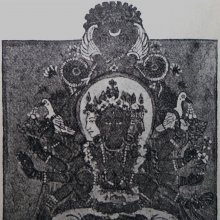Mantranudharini, Mantrānudhāriṇī: 1 definition
Introduction:
Mantranudharini means something in Buddhism, Pali. If you want to know the exact meaning, history, etymology or English translation of this term then check out the descriptions on this page. Add your comment or reference to a book if you want to contribute to this summary article.
Images (photo gallery)
In Buddhism
Tibetan Buddhism (Vajrayana or tantric Buddhism)
Source: archive.org: The Indian Buddhist IconographyMantrānudhāriṇī (मन्त्रानुधारिणी) is another name for Mahāmantrānusāriṇī: one of the five Protector Goddesses (Rakṣa or Pañcarakṣa), commonly depicted in Buddhist Iconography, and mentioned in the 11th-century Niṣpannayogāvalī of Mahāpaṇḍita Abhayākara.—Her Colour is blue; her Symbol is the vajra; she has three faces and twelve arms. Mahāmantrānusāriṇī was probably known in China under the title of Mantrānudhāriṇī.

Tibetan Buddhism includes schools such as Nyingma, Kadampa, Kagyu and Gelug. Their primary canon of literature is divided in two broad categories: The Kangyur, which consists of Buddha’s words, and the Tengyur, which includes commentaries from various sources. Esotericism and tantra techniques (vajrayāna) are collected indepently.
See also (Relevant definitions)
Full-text: Mahamantranusarini.
Relevant text
Search found 1 books and stories containing Mantranudharini, Mantrānudhāriṇī; (plurals include: Mantranudharinis, Mantrānudhāriṇīs). You can also click to the full overview containing English textual excerpts. Below are direct links for the most relevant articles:
The Indian Buddhist Iconography (by Benoytosh Bhattachacharyya)
